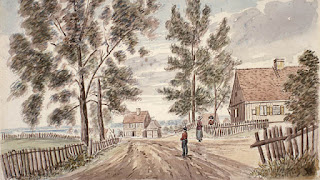For the 25th week of this challenge, I used the optional weekly theme (The Old Homestead) and chose to write about the prairie home of my parents-in-law Bill and Ann Demoskoff.
 |
| Demoskoff family home in late 1952 |
Bill and Ann lived in the central Canadian province of Saskatchewan. Their house wasn’t an ‘old homestead’, but it was their first home as a married couple. Since the house was purpose-built, I decided to record my husband’s childhood memories and conversations we had with his late father about their Prairie family home.
Before he married, my father-in-law Bill owned some property (two quarter sections, each 160 acres) about ten miles north of Pelly, located in Saskatchewan’s Aspen Parkland region. Since neither land had a house, Bill lived about half a mile away to the north of his quarter sections in a house he shared with a friend.
In the spring of 1952, Ann’s brother Larry asked Bill where he and his sister were going to live after their June wedding. My husband doesn’t know what his father replied, but whatever he said, it seems that Larry had other plans. He and his brothers Fred and Pete decided to build Ann a house as their gift to her. (She was their only sister and the youngest of the family.)
The brothers needed lumber, so they asked around to see if any farmers were allowed to harvest timber. Fred eventually found two loads of green timber and borrowed a neighbor’s portable planer to convert the timber to usable lumber. Larry, Fred, and Pete began by digging out a basement (on one of Bill’s quarter sections) using horses to drag out the dirt. They made forms and poured cement to make a foundation. After they back-filled the dirt to the foundation, they started framing the house. Later on, Larry got more sizes of lumber for finishing work, like cupboards.
My husband thinks the house was about 30’ x 40’. It had five rooms on the main floor: a living room, kitchen, pantry, and two bedrooms. A staircase in the living room led to the upstairs, which was divided in two large rooms that were used for storage. While they were young, my husband and his sister shared a bedroom on the main floor, but when he was about six years old, he moved upstairs where the south-facing room was converted into a bedroom for him. The bathroom (outhouse) was fifty feet down the hill at the back of the property.
The front door faced south towards the highway about fifty feet away. The kitchen, which faced north and east, had a wood-burning stove and a cast iron hand pump for water from the basement well. The house was wired for electricity, but Bill couldn’t afford the cost of residential power in the early years. Instead, a wind generator provided energy for indoor lighting.
My husband and his sister (seen above, ca 1963) and their parents lived here until the summer of 1964. That year, Bill sold his farm and moved with his family to the nearby town of Kamsack.
Copyright © 2015, Yvonne Demoskoff.












